BY ROBERT ABELE
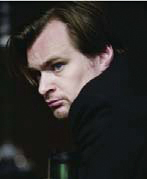 For Christopher Nolan, the British filmmaker who rose to prominence on the strength of psychologically astute, human-sized thrillers like Memento and Insomnia, making a massive, effects-laden Batman movie didn’t mean succumbing to a purely popcorn aesthetic.
For Christopher Nolan, the British filmmaker who rose to prominence on the strength of psychologically astute, human-sized thrillers like Memento and Insomnia, making a massive, effects-laden Batman movie didn’t mean succumbing to a purely popcorn aesthetic.
So when Nolan was charged with reinvigorating the DC Comics superhero for the 2005 movie Batman Begins, he grounded an iconic figure of pen-and-ink origins with an emotional realism: How does someone go from traumatized youth to force for good? The approach extended to how Nolan attacked the action sequences, using computer-generated imagery judiciously to enhance photographic reality rather than to dictate the visual style. “In the end, it has been well worth our while to shoot things in camera as much as possible,” says Nolan, who relied extensively on full-scale sets, detailed miniatures, and complex stunts to shape his film’s dark, recognizably urban look. “Because even where we replaced what we had shot with CG, the CG only worked because we had something in camera we could hold to.”
Perhaps no sequence tested this approach to visual effects more than the hair-raising climactic train chase, in which Bruce Wayne’s beloved Gotham is under threat from Scarecrow’s fear-inducing drug, about to be unleashed citywide by Batman’s former mentor Ra’s Al Ghul. “We wanted to give the audience the appropriately large-scale action finale they would expect, without losing sight of the characters and narrative thread,” says Nolan. “And to be true to the way sort of musical rhythms are used to construct a large film like this.”
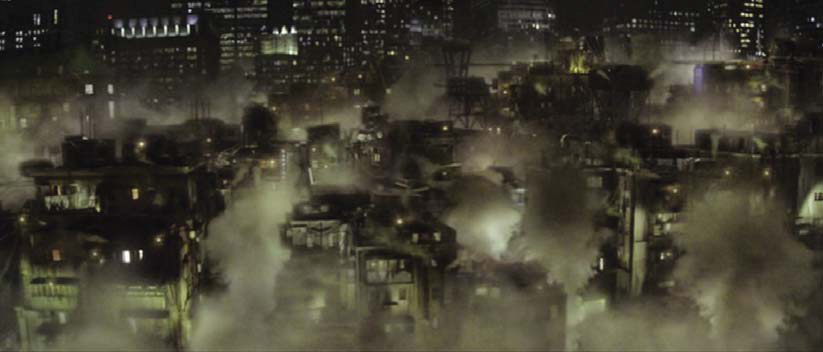
This shot is intended to show the noxious cloud of fear toxin hanging in the alleyways of the Narrows, and then behind we see the taller buildings of Gotham, as yet unaffected. The shot is a combination of a very large-scale model of the Narrows that we shot with motion control so you can get more exposure, and then various 2-D and 3-D fog elements. A lot of lighting elements were tweaked and refined afterwards. I wanted the fog to hang in those alleys and glow from the streetlights. Much of the practical window lights were added after the fact.
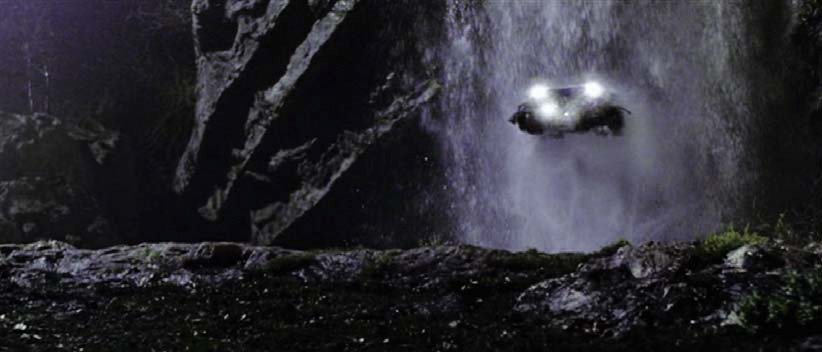
The entrances and exits from the Batcave were one of the trickiest things to do in the film. We elected to do the inside full scale. This is a one-third scale miniature from the outside. The irony is, you call it a miniature, but one-third scale is colossal. The car was 5 feet long and 3 feet wide, and was launched on a powerful catapult, and the car had to be heavily reinforced so the water wouldn’t immediately push it down. To get the water right, the effects guys used compressed air to atomize it to make smaller droplets, so the scale improves. And the camera is overcranked quite substantially.
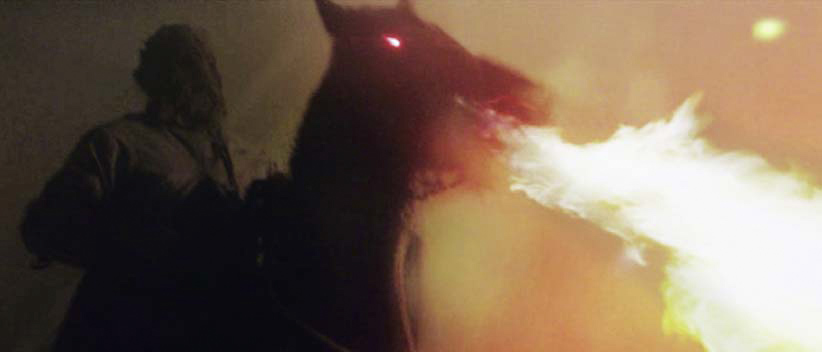
We wanted to represent the effects of Scarecrow’s fear toxin through hallucination. This is the point of view of a kid who’s been affected by the toxin, so we shot this from a low angle. Then we had the visual effects guys add flaming eyes and fire to give it that Sleepy Hollow gothic quality. We were shooting in extremely dense fog that was a combination of steam and mixed-in smoke. This was in an aircraft hangar in Cardington [U.K.] on a scale big enough so that we had an indoors back lot. There was no wind in there, so the fog would sit pretty well. Lighting fog is tricky, because as soon as you backlight it too heavily, you don’t see anything
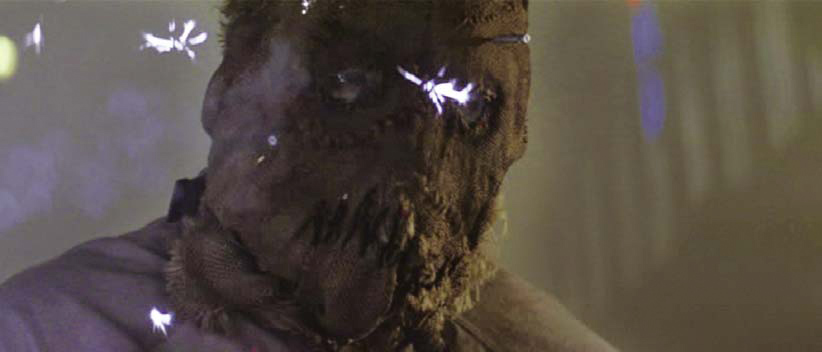
The close-ups of Scarecrow are all Cillian Murphy. With our Scarecrow mask, we wanted a creepy modern quality yet somewhat gothic, so it’s really just a sack with stitching and holes for eyes. We had devised an elaborate rig for him to sit on to simulate movement of a horse, but it turned out the best way to do it is just get the horse trainer to put Cillian on his shoulders, and to just have the trainer bobbing and weaving like a horse. With fog, the closer you get to objects, the foreground fog tends to completely disappear, so we had to add in smoke by hand just below the camera frame, to make it work psychologically for the audience.
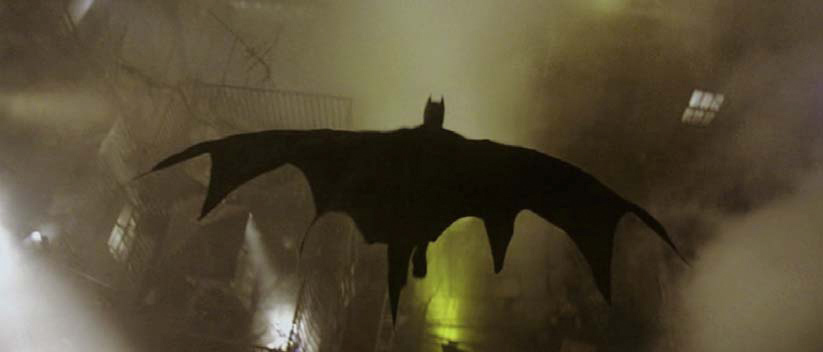
We wanted a sense of Batman diving down into this apocalyptic scenario. We had two cable rigs, one for the stunt guy and one for the cable camera that would move independently. They would launch in concert so it would track above Batman as he went down. Then, the visual effects guys said they could have the wings open more effectively— I wanted it to be like a parachute opening— so I said, ‘When it’s indistinguishable in terms of reality from what we have on the in-camera shot, we’ll swap it out.’ So in this shot, everything is real, except the stuntman has been replaced by the CG Batman. But we retained the original cut points in the edit.
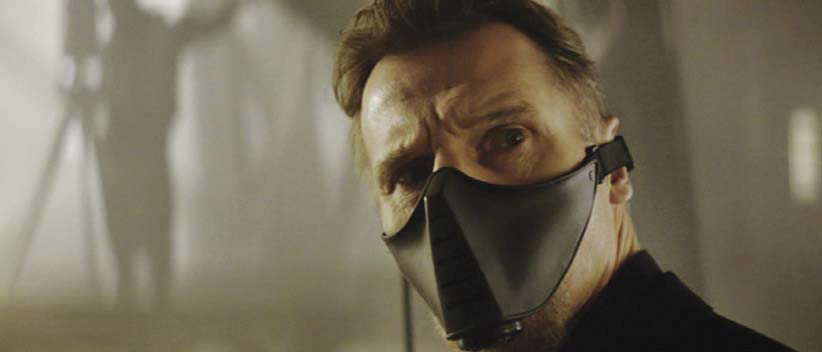
This is about framing and highlighting Ra’s Al Ghul’s [Liam Neeson] realization that the hero is still alive. It’s a classic moment in big popcorn movies from my childhood. I wanted this to be a dolly-in, but we actually shot it on the Steadicam, and [operator] Steve Adelson did a good job of making it feel like a dolly shot. We were about three stories up on our own fake rooftop set. There’s a full-scale monorail-like tower that we constructed behind them, and once again, everything is full of fog. It was such a huge job that we finished the turnaround onto Batman weeks later. It was simply impractical to light up both sides on that set the same day.
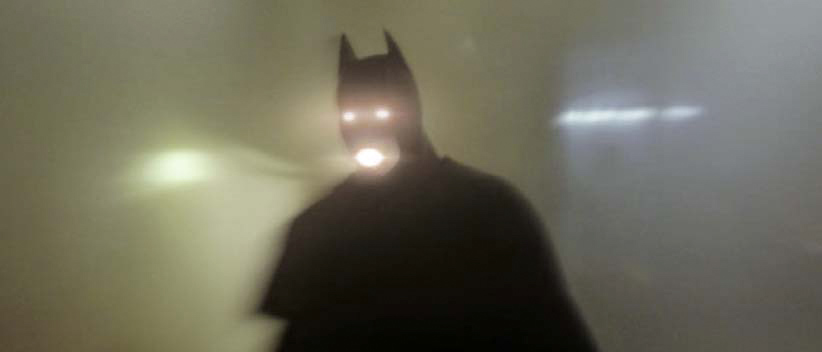
Just as we did with Scarecrow, I wanted to show how the hallucinating version of Batman would look to the terrified inhabitants of the Narrows, like a demon. We had several full-body makeups that were extensive and took hours, but somehow it was too real in a way. So we used a shot of normal Batman in the fog, then enhanced it through visual effects to give him this set of glowing eyes and light emitting from his mouth. And there’s an interesting shaky quality to suggest the vibrating meniscus on a pond surface, like microscopic photography. Then we put a very low sound effect on to synchronize with the vibration.
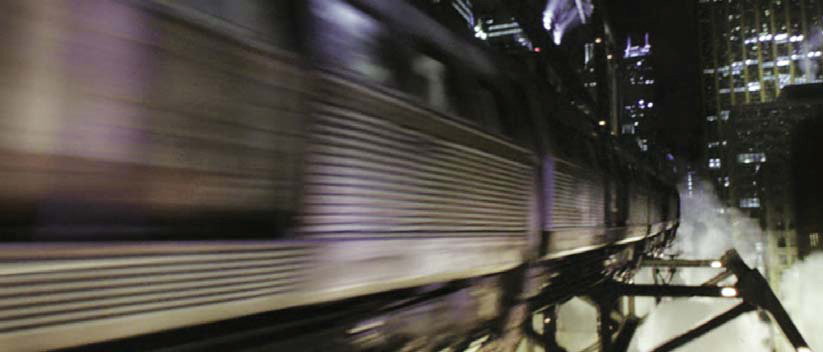
The shot here is fully CG. I wanted the fully CG shots to feel very much the way our in-camera shots were going to feel. I didn’t want the CG to stand out. So I would block the shots using animatics, according to the way it felt if we could really place a camera near a train, and how we would really shoot it to maximize speed. Then we’d take the film elements, plate elements of the city, and photographic film elements of the very large-scale miniature train we constructed, and combine them into these fully CG shots.
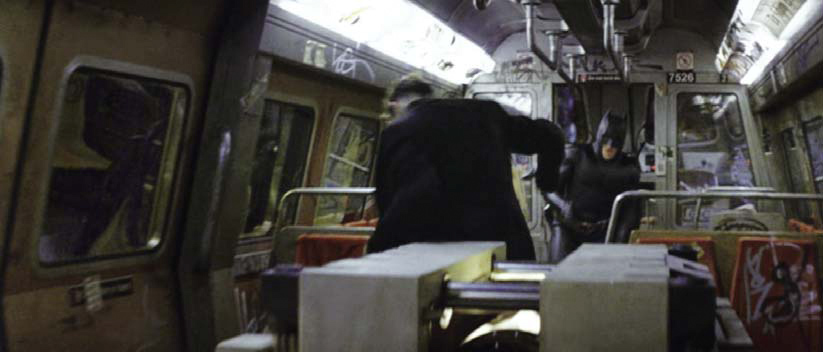
We built two carriages of the train, full size, and shot on a large 360 green-screen stage. [DP] Wally Pfister would light it 180 degrees at a time. The entire thing was gimbaled, and we did a certain amount of shaking. It was a very confined space, and handheld was the way to go. The actors learned the fight very well, so we were able to run it many times in rapid succession and be very spontaneous about the sort of shots we would grab. It puts more of a burden on the actors to do the fight multiple times, but I think it allows you to really get the camera in the right place for each setup.
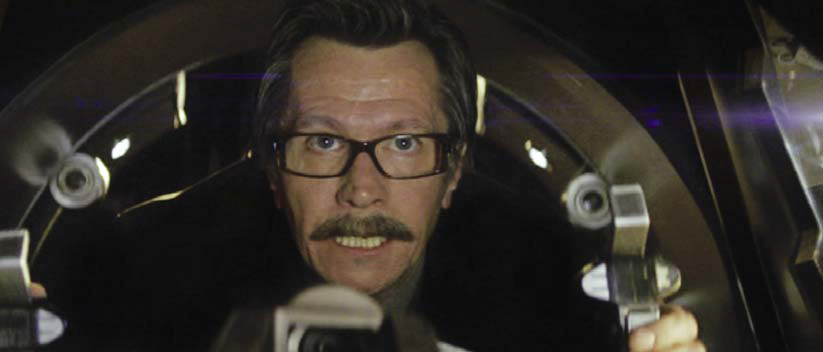
We had a Batmobile interior on a gimbal. Gary [Oldman, who plays Sgt. Gordon] then moves down into the gunner position, which is a pod between the front tires of the car. The setup he’s in is on a gimbaled ring, so we would swing the Batmobile as it’s bumping and bucking, clockwise and anti-clockwise, and that front pod could move independently. At this point, he’s lining up to blow up the monorail tower. With a great actor like Oldman, it really doesn’t faze him to be looking at nothing but a bunch of grips and electricians. He’s able to ignore the green screen and tap into the psychological reality of the situation.
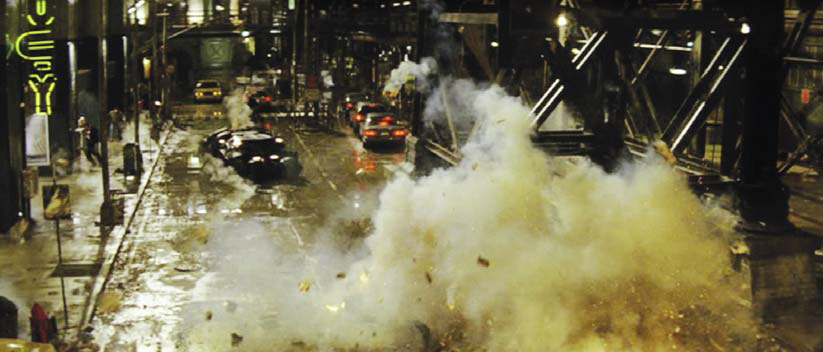
Gordon blows out the foundations of the monorail tower, and this shot is a full-size shot that shows our largest street section on the lot, which is 800 feet long and 400 feet wide. The leg of the tower went up a good 80 feet, and we blew it up for real. It had to be extremely carefully planned. The special effects guys built it so they knew exactly where it was going to land. When it comes to these massive, unrepeatable setups, you’ve got to have six or seven cameras in there. But it puts a lot of demand on the DP, because you’re using very wide lenses, he’s got to light for multiple angles, and you’ve got to keep the lights out of shots.
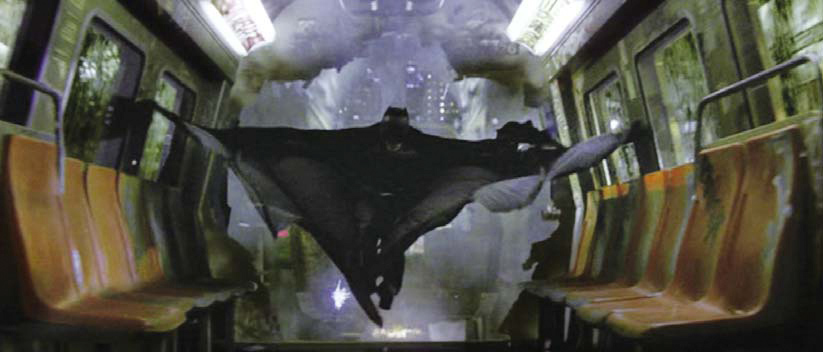
Here, the back of the train comes off because of Batman’s explosive, and that is a real stuntman being dragged back by a cable that takes him out of the train and lifts him up away from it. The action of him catching the wind and blowing out the back is completely real. He’s using a cape that actually inflates, with rods extending out from his arms. The trick was to time it so they didn’t get caught on the edges of the train. Then we did some 2-D visual effects enhancements to the cape because we weren’t able to blow the right amount of wind at him without swinging him dangerously in the wrong direction.
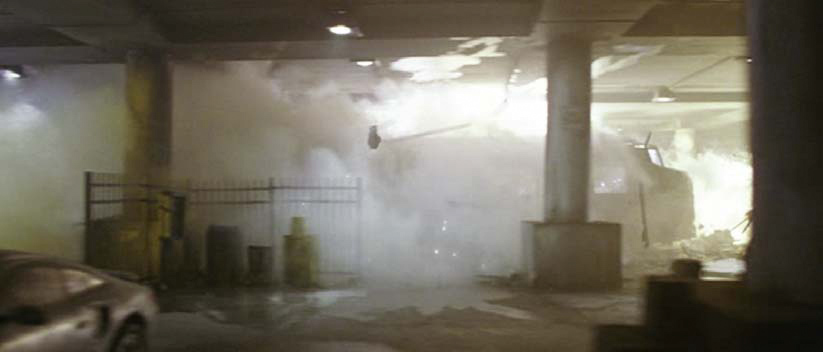
Having smashed through the surface of the street, the train carries on through these underground parking garages. It was shot using an extensive miniature, and very small CG enhancements, like glass blowing out on the windows of cars. The train is pulled through the miniature on a cable rig, and the camera is pulled through on its own separate rig, to give it sort of a tracking shot. We tried to do all the visual effects in VistaVision, but there weren’t enough of those cameras so we decided to go Super 35 and risk the images being a little grainier. We then de-grained and sharpened the images through the visual effects company.
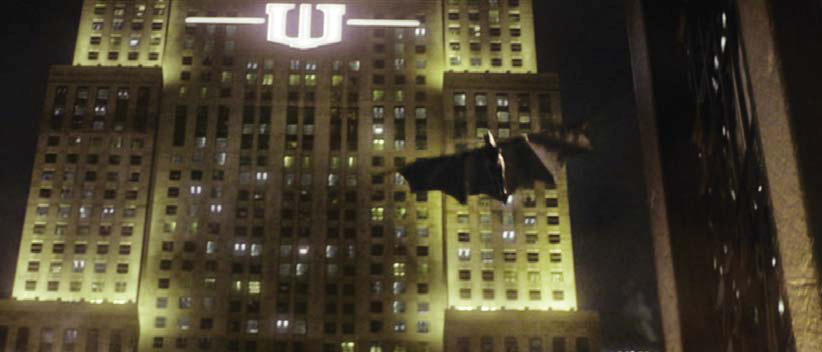
We wanted to give Batman a nice restful flight across the scene of devastation, and we framed it against Wayne Tower to relate it back to the history of the character. This shot is fully CG, and it took a lot of work for the visual effects guys to match the lighting and contrast levels. Often with night imagery in CG, there’s an unusual level of fill light and that provides a gloss that’s quite attractive. We looked at what you’re actually able to photograph in a city at night where you can’t control fill light, and there’s a disappointing lack of detail. I think you have to continue that lack of detail in your CG shots to maintain the realism we were shooting for.